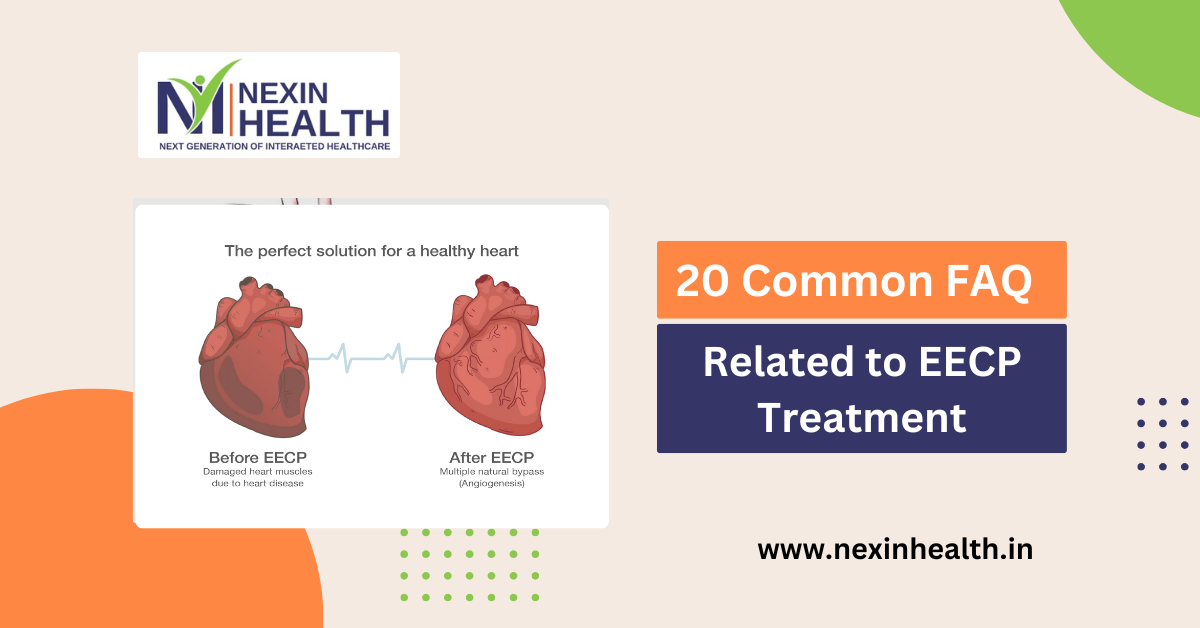Common FAQ Related to EECP Treatment


FAQ Related to EECP Treatment: EECP (Enhanced External Counterpulsation) is a non-invasive treatment often recommended for people suffering from angina, heart failure, and other cardiovascular conditions. With growing interest in this alternative therapy, many people have questions about its safety, effectiveness, and outcomes.
Below is a detailed FAQ guide to answer the most common questions related to EECP treatment.
EECP (Enhanced External Counterpulsation) is a non-invasive therapy that improves blood circulation to the heart by applying pressure to the lower limbs. This encourages collateral blood vessels to form, potentially reducing chest pain (angina) and enhancing overall heart function.
During an EECP session, inflatable cuffs are placed around the patient’s calves, thighs, and hips. These cuffs inflate and deflate in sync with the heartbeat, pushing blood back toward the heart. This helps improve circulation and opens collateral vessels to bypass blocked arteries.
EECP treatment is commonly recommended for:
Yes, EECP is considered a safe and non-invasive procedure. Since it does not involve surgery or anesthesia, the risks are minimal. However, patients with certain conditions, such as uncontrolled hypertension or recent deep vein thrombosis, may not be suitable candidates.
Patients experiencing frequent chest pain or fatigue due to heart-related conditions and who are not candidates for surgery (or have not responded to other treatments) can benefit from EECP. A cardiologist can determine whether EECP is right for a patient based on their medical history and symptoms.
Each session takes about 60 minutes. The patient lies on a treatment table, and cuffs are wrapped around the legs and hips. The cuffs inflate and deflate rhythmically in time with the patient’s heartbeat to assist blood flow. Sessions are usually painless, and the patient can relax, read, or watch TV during treatment.
A standard course of EECP treatment consists of 35 one-hour sessions spread over 7 weeks (5 days a week). Some patients may require additional sessions based on their condition and response to the therapy.
Most patients find EECP treatment comfortable and painless. However, some may experience mild discomfort due to the compression of the cuffs, especially in the initial sessions. Adjustments to cuff pressure can be made to ensure patient comfort.
Results vary from patient to patient. Many individuals start noticing improvements in their symptoms and energy levels within 2–4 weeks. Others may experience full benefits after completing the entire course of 35 sessions.
EECP is generally well-tolerated. Minor side effects include bruising or mild soreness in the legs due to the pressure from the cuffs. Rarely, patients may experience back pain or fatigue, which typically resolves with time.
While EECP can provide significant relief and improve heart function, it is not a direct replacement for bypass surgery or angioplasty. It is often recommended for patients who are not candidates for surgery or who seek non-invasive alternatives.
Studies have shown that 75–80% of patients with angina report reduced symptoms after completing EECP therapy. Additionally, improved circulation can enhance overall heart health and reduce dependency on medications for some individuals.
EECP therapy is covered by many insurance providers, including some government programs, particularly for patients with chronic angina. It’s essential to check with your healthcare provider or insurance company to confirm coverage details.
Yes, most patients can continue their usual activities and work schedules while undergoing EECP therapy. There is no downtime associated with the treatment, though some individuals may feel slightly fatigued after sessions.
EECP is particularly beneficial for elderly patients who are not suitable candidates for invasive heart procedures. It improves circulation, reduces symptoms of angina, and enhances overall quality of life with minimal risks.
Yes, diabetic patients with heart conditions can benefit from EECP. The treatment can improve circulation and alleviate chest pain, which is especially important for people with diabetes, who are at higher risk for cardiovascular issues.
Patients are advised to wear comfortable, loose-fitting clothing to their sessions. Tight jeans or restrictive garments should be avoided as they can interfere with the cuff inflation.
While there are no major restrictions, patients are encouraged to maintain a healthy lifestyle during and after treatment. A balanced diet, regular physical activity, and stress management techniques complement the benefits of EECP therapy.
If you’re looking for EECP treatment in Noida, NexIn Healthcare is a leading center offering advanced EECP therapy. With experienced professionals and state-of-the-art facilities, NexIn Healthcare ensures a comfortable and effective treatment experience for patients seeking non-invasive heart care.
Also Read:
EECP treatment is a promising alternative for individuals suffering from chronic angina and heart conditions. It offers numerous benefits, such as improved circulation, reduced symptoms, and enhanced energy levels, without the risks associated with invasive procedures. For those in Noida looking for expert care, NexIn Healthcare – EECP Treatment in Noida is an excellent option to consider.
Also Read: